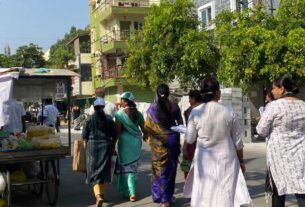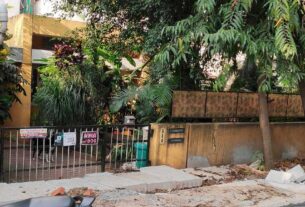Women commuters struggle as they avoid using washrooms in metro stations due to their unhygienic conditions.
Lack of dustbins in washroom stalls and non-functioning water taps in major metro stations in the city leave women commuters stranded during their metro rides.
“I find the washrooms to be really smelly; and they often don’t have soap or enough water in the taps as well,” said Aishwarya Vijay, a college student. Additionally, some washrooms did not have dustbins inside the stall which made it difficult to dispose of sanitary waste, said Akshita Goyal, a frequent metro traveler. In fact, one of the stalls in Mantri Square metro station had a sanitary pad lying outside the bin, she said. A similar situation persists in Delhi metro trains too. “Taps are leaky and handwash is always just water,” said Danita Yadav, a Delhi metro passenger.
Sanitation and hygiene are a huge concern for women in washrooms, said Aila Bandagi, an activist and urban researcher on gender and cities. “For women who are pregnant or menstruating, clean toilets are a necessity,” she said. In the absence of such facilities, women either choose to not go on the trip which could affect their work or education or if they can afford it, they shift to private transport, which in the long run is neither good for the environment nor the city, she added.
However, Ravi Prakash, Senior Manager of Bengaluru Metro Rail Corporation (BMRC) maintained that frequent checks of the washrooms are conducted. “The washrooms are cleaned thoroughly by the housekeeping staff every two or three hours, starting in the morning,” he said.
Under the Swacch Bharat Mission guidelines, all Urban Local Bodies (ULBs) must ensure that there should be at least one public toilet available at every public place including metro stations, and that the facility should be kept functional and open for public use. Additionally, guidelines provided by the Central Public Health and Environmental Engineering Organisation (CPHEEO), advised that the locations of public toilets in cities need to be highly visible. The design considerations of the toilet facility should ensure ease of access for all, the report said.
However, washrooms inside the metro station are only available near the entry or exit points, meaning that one must buy a ticket and pass the scanning area to use the washroom. Once you exit the platform, your one time ticket goes to waste due to an emergency situation, said Sonal, a college student.
Some commuters have resorted to not using washrooms inside the station. “I triple check before I leave home to ensure that I don’t have to use the washrooms at the stations,” said Vijay who uses the metro train daily to go to college. Even in cases of emergencies, women try to avoid using it. “I would rather not use the washroom than get some disease because of using it,” said Vedika Mevawala, a passenger. The situation is similar in Delhi as well. “I only use the washrooms if I am desperate to go otherwise I hold it in,” said Yadav.
Due to the lack of accessibility to clean facilities, women go hours without using a toilet which could lead to Urinary Tract Infection (UTI) other infections, according to a study by the International Journal of Community Medicine and Public Health.
Although urban planning and design are extremely complex and cannot have one solution, route planning, sanitation, accessibility, affordability and comfort are some of the parameters that need to be addressed or altered to make the commute safe for women, said Bandagi.
However, washrooms are not going to be built in any other location in the station other than where the current ones are built, said Prakash. “If it is built anywhere else, then anyone can come and use it without buying a ticket and spoil the washroom,” he added.




